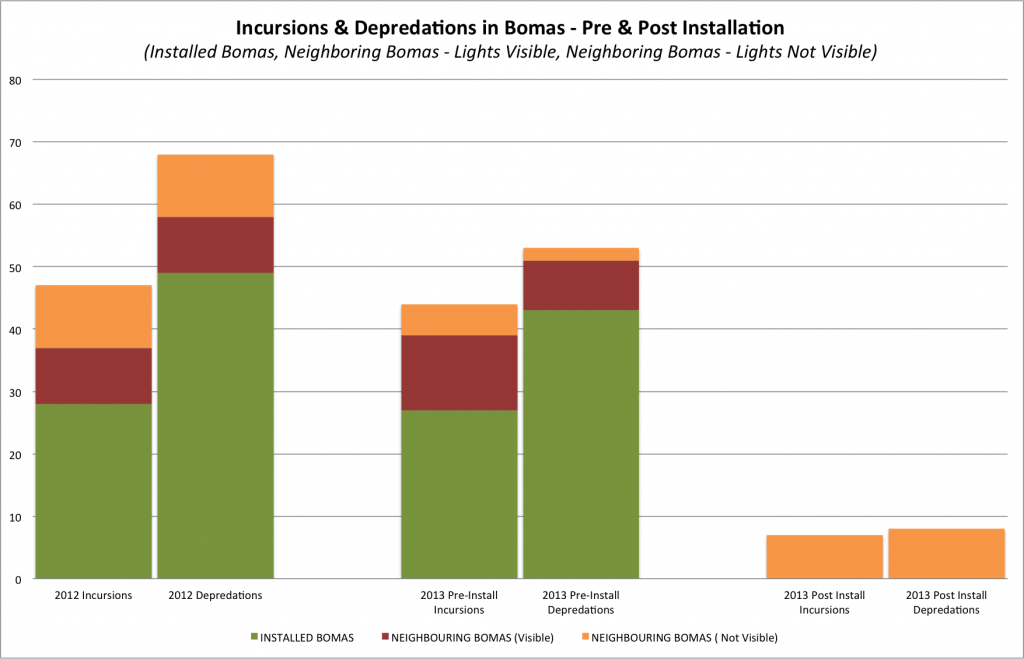Lighting it up!

Earlier this year, to combat an increase in livestock depredation by lions, Lion Guardians and the Kenya Wildlife Trust (KWT) teamed up to bring Lion Lights to nine separate bomas in the Amboseli ecosystem.
Lion Lights are an automated lighting system designed to deter large predators such as lion, leopard, hyena and cheetah, from killing livestock held in enclosures. This simple device was invented by an 11-year-old boy, Richard Turere whose family and neighbors were faced with predator incursions and livestock depredation on almost a daily basis in Kitengela (an area bordering the Nairobi National Park). The device is essentially a system of torches that flash intermittently. These intermittent flashes simulate the movement of a person around the boma and thereby deter predators. Actually, one of the most admirable aspects of the whole system is that it can be moved from one boma to another depending on the pastoralists’ movement patterns. Michael Mbithi and David Mascall refined the basic system developed by Richard and now solar-powered prototypes are being trialed in several locations.
In order to determine where the Lion Lights would be installed, the Lion Guardians team conducted a survey, in the group ranches of Eselenkei, Mbirikani and Olgulului, to establish which bomas experience the most lion incursions. In addition, we included Kunchu community land adjacent to Selenkay Conservancy, as there were a lot of livestock depredations by lions in that particular area as well. The survey was conducted over a period of two weeks. Lion Guardians also asked the community members to recommend the bomas that should get the Lion Lights based on their knowledge.
At the end of the two-week survey, we compared the recommendations made by community members with those emerging from the Lion Guardians’ program conflict data. Encouragingly, the results were very similar. Following the confirmation of which bomas were to get the system, the Lion Lights were successfully installed by Michael Mbithi and his project team, in close collaboration with the Lion Guardians in each chosen area.

Since the installation in early June, Lion Guardians have been monitoring the incursion and depredations in the bomas with Lion Lights as well as the bomas neighboring them. Whilst our sample size is not statistically significant so as to draw long-term conclusions, the data we have collected does have positive indicators. As of now, all of the nine bomas fitted with Lion Lights have not experienced further carnivore incursions since the installation. Boma owners also openly admit that they now enjoy peaceful sleep at night. They told us that even when they observed predator tracks as close as 100 meters from the boma these predators had not entered the boma.

Furthermore, neighbors to Lion Lights bomas have also expressed having felt the impact and protection of the lights at night. In fact, our current data shows that when the Lion Lights are actually visible from the neighboring boma then there are no incursions and depredations in those bomas either. There have however been reports of bomas (outside of our trial group) with Lion Lights suffering incursions. For instance, one boma at Nkiito in Olgulului Group Ranch (Lion Lights system was installed in November 2012) did experience a lion incursion. The culprit was a female lion nicknamed Asama who within the same week had killed a sheep inside a Born-Free fenced boma! Experts attributed the incursion to too much spacing between the Lion Lights.
Overall the Lion Lights also appear to be easy to use but boma owners have faced certain challenges. For example, users have overloaded the system by charging other electronics, they have also suffered a lack of power especially during colder months of June and July, and the required maintenance of the solar panel has challenged several bomas. However, Lion Guardians have monitored the situation and always responded as quickly as possible to address these issues.
All said and done, the Lion Lights system is simple by design, affordable, easy to manage and is a valuable tool in the conservation toolkit for reducing predator – human conflicts on community lands.



It’s good to see that Richard’s idea is being refined and applied in the field! I work in Namibia with communities that experience livestock losses to lions. I am wondering if I could order some Lion Lights for my project and, if so, how we could go about transporting them to Namibia? Could you please email me if you think that this will be possible.
Gail,
Please email me at olaro43@hotmail.com regarding your lion light queries.
we have a new edition lion light system that is more durable.
Michaek Mbithi
Great! Richard Turere’s idea seems to have ripple effects too. Once the communities get used to the idea of solar panels, they will surely find other uses too. This must be modern technology in its least intrusive form, isn’t it?